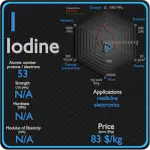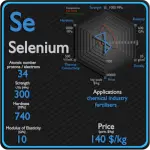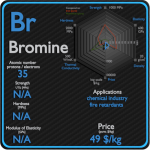This article contains comparison of key thermal and atomic properties of bromine and iodine, two comparable chemical elements from the periodic table. It also contains basic descriptions and applications of both elements. Bromine vs Iodine.

Bromine and Iodine – About Elements


Source: www.luciteria.com
Bromine and Iodine – Applications
Bromine
A wide variety of organobromine compounds are used in industry. Some are prepared from bromine and others are prepared from hydrogen bromide, which is obtained by burning hydrogen in bromine. Brominated flame retardants represent a commodity of growing importance, and make up the largest commercial use of bromine. One of the major uses of bromine is a water purifier/disinfectant, as an alternative to chlorine. Bromine compounds are effective pesticides, used both as soil fumigants in agriculture, particularly fruit-growing, and as a fumigant to prevent pests from attacking stored grain and other produce.
Iodine
In addition to nutrition products, iodine and iodine derivatives are used in a wide range of medical, agricultural, and industrial applications. About half of all produced iodine goes into various organoiodine compounds, another 15% remains as the pure element, another 15% is used to form potassium iodide, and another 15% for other inorganic iodine compounds. The leading application is in the production of X-ray contrast media (22%). Iodine’s high atomic number and density make it ideally suited for this application, as its presence in the body can help to increase contrast between tissues, organs, and blood vessels with similar X-ray densities. It is used as an antiseptic for external wounds. Another application driving the demand for iodine is in polarizing film in liquidcrystal display (LCD) screens.
Bromine and Iodine – Comparison in Table
| Element | Bromine | Iodine |
| Density | 3.12 g/cm3 | 4.94 g/cm3 |
| Ultimate Tensile Strength | N/A | N/A |
| Yield Strength | N/A | N/A |
| Young’s Modulus of Elasticity | N/A | N/A |
| Mohs Scale | N/A | N/A |
| Brinell Hardness | N/A | N/A |
| Vickers Hardness | N/A | N/A |
| Melting Point | -7.3 °C | 113.5 °C |
| Boiling Point | 59 °C | 184 °C |
| Thermal Conductivity | 0.122 W/mK | 0.449 W/mK |
| Thermal Expansion Coefficient | N/A | N/A |
| Specific Heat | 0.473 J/g K | 0.214 J/g K |
| Heat of Fusion | 5.286 kJ/mol | 7.824 kJ/mol |
| Heat of Vaporization | 15.438 kJ/mol | 20.752 kJ/mol |










